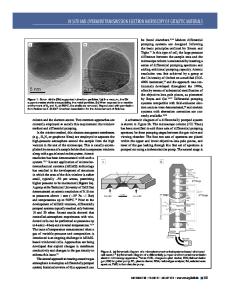In situ transmission electron microscopy investigation of radiation effects
- PDF / 6,512,075 Bytes
- 30 Pages / 612 x 792 pts (letter) Page_size
- 84 Downloads / 419 Views
K. Furuya National Institute for Materials Science, Tsukuba, Ibaraki 3015-0003, Japan
G.R. Lumpkin University of Cambridge, Cambridge, CB3-6DA United Kingdom
M-O. Ruault Center Nuclear Spectrometry and of Mass Spectrometry-Orsay, Orsay F-91405, France (Received 18 January 2005; accepted 7 April 2005)
In situ observation is of great value in the study of radiation damage utilizing electron or ion irradiation. We summarize the facilities and give examples of work found around the world. In situ observations of irradiation behavior have fallen into two broad classes. One class consists of long-term irradiation, with observations of microstructural evolution as a function of the radiation dose in which the advantage of in situ observation has been the maintenance of specimen position, orientation, and temperature. A second class has involved the recording of individual damage events in situations in which subsequent evolution would render the correct interpretation of ex situ observations impossible. In this review, examples of the first class of observation include ion-beam amorphization, damage accumulation, plastic flow, implant precipitation, precipitate evolution under irradiation, and damage recovery by thermal annealing. Examples of the second class of observation include single isolated ion impacts that produce defects in the form of dislocation loops, amorphous zones, or surface craters, and single ion impact-sputtering events. Experiments in both classes of observations attempt to reveal the kinetics underlying damage production, accumulation, and evolution.
I. INTRODUCTION 1
Since 1961, when Pashley and Presland reported observations using an 80-kV transmission electron microscope (TEM) of damage in Au resulting from negative ions accelerated out of the electron source of the TEM, the area of in situ TEM studies of ion irradiation effects has become well-established for both fundamental and applied irradiation effects research. Initially, radiation damage studies focused on issues associated with nuclear reactors; however, the field has expanded to include additional areas of nuclear waste, semiconductor processing, degradation of components in space or other radiation environments, ion implantation, imperfections in materials, and nanoscale science. Experiments have Address all correspondence to this author. a) e-mail: [email protected] b) This author was an editor of this focus issue during the review and decision stage. For the JMR policy on review and publication of manuscripts authored by editors, please refer to http:// www.mrs.org/publications/jmr/policy.html. DOI: 10.1557/JMR.2005.0242 1654
J. Mater. Res., Vol. 20, No. 7, Jul 2005
examined a wide range of damage from single-ion impacts to 100 displacements per atom. This review will present a wide variety of examples from several different disciplines. While this review focuses on the use of in situ TEM observations to investigate ion-beam effects, many in situ electron irradiation experiments have been performed in high-voltage electron micros
Data Loading...










